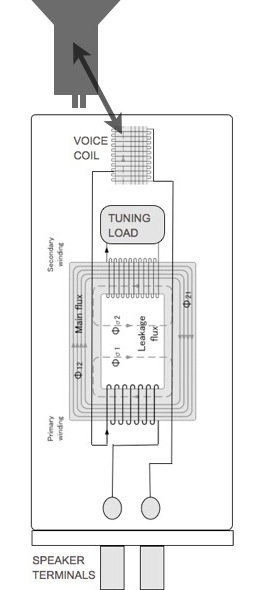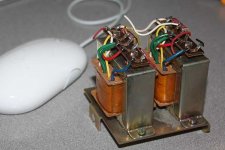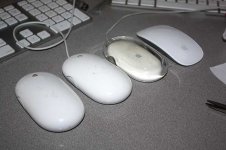I'd hate to see someone drop $400 a driver for a filter, but will be very interested in someone reverse engineering it, or just figuring out how to diy it. I suspect the same could be done for an awful lot less, (i'm guessing $700 left in your pocketand without the silly can on the back)
It is hard to swallow what seems to me to be deceptive marketing that comes along with this driver... you should see what some on the JoeList had to say about Steve's marketing blather.
dave
It is hard to swallow what seems to me to be deceptive marketing that comes along with this driver... you should see what some on the JoeList had to say about Steve's marketing blather.
dave
Well the "filter" changes Qt, Re and straighten any peaks and dips without reducing the efficiency, so it may be well worth 400 bucks.
I've seen some modded german drivers sold for much more, for just a magnet replacement (alnico).
I'm not making names but it's pretty obvious.
I've seen some modded german drivers sold for much more, for just a magnet replacement (alnico).
I'm not making names but it's pretty obvious.
Well the "filter" changes Qt, Re and straighten any peaks and dips without reducing the efficiency
Not in itself particularly difficult. Compare the Decware plot to the Dayton one. Granted, that isn't the easiest task because they're using different scales, plus, the Decware measurement was taken loading their OB design, not an IEC standard baffle for measuring drivers. However, if you allow for that, you will note that the Decware plot indicates ~93dB as average efficiency. The raw Dayton unit conversely peaks up considerably above 1KHz; they've actually taken their average as 95.5dB. However, if you flatten it out with a shelving circuit (be it transformer coupled or otherwise) you will note that efficiency matches that of the modified Decware unit.
Last edited:
Not in itself particularly difficult. Compare the Decware plot to the Dayton one. Granted, that isn't the easiest task because they're using different scales, plus, the Decware measurement was taken loading their OB design, not an IEC standard baffle for measuring drivers. However, if you allow for that, you will note that the Decware plot indicates ~93dB as average efficiency. The raw Dayton unit conversely peaks up considerably above 1KHz; they've actually taken their average as 95.5dB. However, if you flatten it out with a shelving circuit (be it transformer coupled or otherwise) you will note that efficiency matches that of the modified Decware unit.
Plots overlaid with same scales.
Excuse the rez of the PE plot... the PDF has a bad encrypt dictionary and comes up as a bank page (an inquiry to PE got zero response), all i had to work with was a lowish rez screen capture that some kind person sent me.
dave
dave
Attachments
I believe that natural tone & details of the speaker depends on linearity of the frequency response (with other factors). I was looking for a full range whose response is as linear as possible. I looked at Voxativ, Fertin, Feastrex, etc frequency responses and was ready to drop a good amount of money. But after comparing 1/48 octave smoothing response of this driver to others which were 1/12 (rare) or 1/3 (very standard for most of the manufacturers) I was disappointed with exotic drivers.
You should try EMS-speaker. Either the 7" or the 12" are very linear without the need of equalization.
They are my first choice for a classic cone fullrange driver, but I could try these decware first because would be a drop-in into my current OBs.
...but will be very interested in someone reverse engineering it, or just figuring out how to diy it.
So, any guesses where to start? Looking at the "Principal of Operation" diagram, it's just an air gapped transformer and a resistor. Does anyone care to guess what ratio it might be? If there is any useful info in the diagram, the "primary" has fewer turns than the "secondary". Could I just mess around with a typical 5K:8 SE OPT? What value would be reasonable for the resistor?
Scott: yep, but OB efficiency is usually lower, so I dont think it's loss because of the EQ.
OB efficiency is only lower in the LF. Above the region of baffle-losses, efficiency is the same as a box speaker or any other load other than a front-horn. The Decware modifications are essentially a transformer-coupled shelving filter which flattens out the frequency peaking of the unmodified Dayton unit and brings it to a ~flat 93dB. Dave's overlay above demonstrates this fairly clearly: take the Dayton FR graph, and draw a horizontal line from 1KHz upward. Where does it come out? Exactly where the Decware's FR is. I suspect Steve has added a couple of extra notch filters to the circuit to flatten out the ~3.5KHz & ~16KHz peaks too, although his extra roll-surround may have damped some cone resonances.
Last edited:
To start, it would be nice to have someone on board who has a better experience with transformer manipulations than i. We have to remember that a transformer also has a big inductance component and at least a little C.
On top of that i doubt Steve is putting all his cards on the table. Nothing stopping the tuning load from having caps & chokes as well... their impedance will be reflected by the transformer.

Where he says air gapped transformer, my mind immediatly thot of the transformers from his SE amps. A ZEN OPT would fit nicely in that can.
dave
On top of that i doubt Steve is putting all his cards on the table. Nothing stopping the tuning load from having caps & chokes as well... their impedance will be reflected by the transformer.

Where he says air gapped transformer, my mind immediatly thot of the transformers from his SE amps. A ZEN OPT would fit nicely in that can.
dave
Where he says air gapped transformer, my mind immediatly thot of the transformers from his SE amps. A ZEN OPT would fit nicely in that can.
I guess in lei of an expert some experiments could be conducted.
Telefunken 12k to 4R on hand, have to get some measuring kit set up down here. (please no one hold their breath)
dave
Attachments
Well, he took the Gigawork DAC ($140 approx.) slapped it in a cheap case and resells it for $800!
For a second I thought he added a beer cooler to that driver
Is that really the case do you think? If so that would kind of suck, I'm sure it at least had to be reworked if it is in fact the case?, but I know nothing...
Cool that some here are looking into modding this driver, seems like a pretty good buy if it can be tweaked to work out as stated by Steve etc.. Maybe it could be used as a nice fullrange OB project here at DIY if the q can be raised, maybe a helper woofer also, MJK h-frame come to mind or ?
Nice enough looking driver in stock form, should have some potential for a reasonable price of admission to boot!!
Last edited:
I looked at it too, after the early posts here caught my eye when browsing the home page and looking at random posts...
The thing that bothers me is that the claimed final response seems too good to be true. Boy would it be great if it was true! Or, how could that be right?? I have measured two other drivers that were pretty much ruler flat, that out of many many... so I suppose it is possible. But turning a non-flat driver into a flat driver implies a great many inherent issues got solved, which is very hard to do... definitely something to think about.
I will look forward to someone getting a pair and measuring them, posting the measurements...
If it does perform as published, then I guess it is a good price, yes??
_-_-bear
The thing that bothers me is that the claimed final response seems too good to be true. Boy would it be great if it was true! Or, how could that be right?? I have measured two other drivers that were pretty much ruler flat, that out of many many... so I suppose it is possible. But turning a non-flat driver into a flat driver implies a great many inherent issues got solved, which is very hard to do... definitely something to think about.
I will look forward to someone getting a pair and measuring them, posting the measurements...
If it does perform as published, then I guess it is a good price, yes??
_-_-bear
Is that really the case do you think? If so that would kind of suck, I'm sure it at least had to be reworked if it is in fact the case?, but I know nothing...
Decware DAC. Looks like he applied a conformal coating to the board.
An externally hosted image should be here but it was not working when we last tested it.
Gigawork DAC
An externally hosted image should be here but it was not working when we last tested it.
Steve also claims you can get 24 bit 96KHz from USB without any drivers. Not true.
Source: Audiophile Tube Amps and Tube Gear from DECWARE
I have place an order for FRX and soon I will receive it. I will let you know how it sounds and measure. Meanwhile, I already have dayton PS180 6.5" fullrange in BLH. It is a best driver I have come across. It just disappear completely and has very good imaging. The top end is good but not clean as the FR already indicates. So I have augmented it with ribbon tweeter. Highly recommended. Aside from how it sounds, I was able to try Steve's coupling transformer concept with dayton 6.5". I had push pull OPT from one tube amp which I tried it with. Just connected this in series with the driver with a variable resistor. Not a great success but one thing I confirmed that the highs were attenuated based on resistor value and there was no sound if I remove the resistor from secondary winding.
Now you might ask a question why I would order FRX. Well to get Steve's results, I will have to buy a lot more expensive instruments & dont know how many SE OPTs which are expensive to begin with and also the time. So net in net, for me I left it to the expert and saved some money. If you are expert in tweaking, your mileage may vary.
creek
Now you might ask a question why I would order FRX. Well to get Steve's results, I will have to buy a lot more expensive instruments & dont know how many SE OPTs which are expensive to begin with and also the time. So net in net, for me I left it to the expert and saved some money. If you are expert in tweaking, your mileage may vary.
creek
As far as I am aware the driver frequancy correction dosen't need a transformer as all the transformer consits of in a linier sense is inductance, resistance and capacitance, the seconady impedance will be transformed which may present a better load to the amplifier but nothing magical can happen with regards to a transformer that couldn't be achived via equalisation.
- Status
- This old topic is closed. If you want to reopen this topic, contact a moderator using the "Report Post" button.
- Home
- Loudspeakers
- Full Range
- New FRX OB driver from Decware


